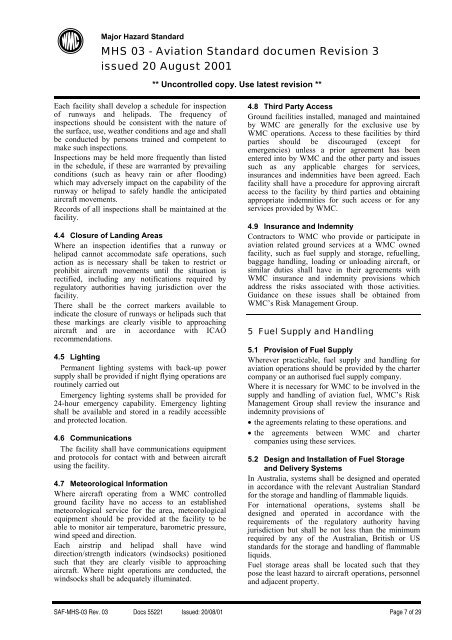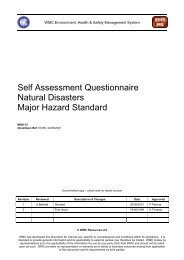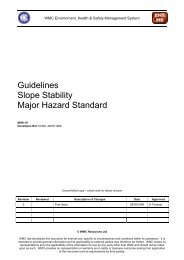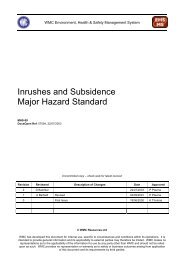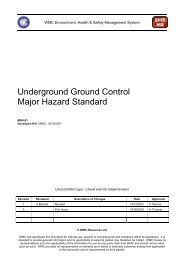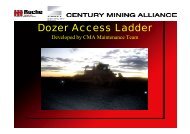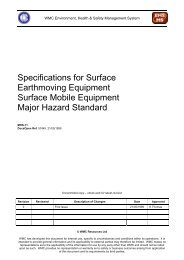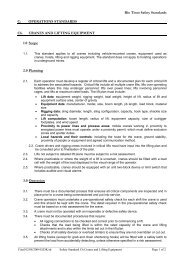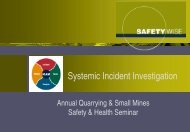Aviation Major Hazard Standard - MIRMgate
Aviation Major Hazard Standard - MIRMgate
Aviation Major Hazard Standard - MIRMgate
Create successful ePaper yourself
Turn your PDF publications into a flip-book with our unique Google optimized e-Paper software.
<strong>Major</strong> <strong>Hazard</strong> <strong>Standard</strong><br />
MHS 03 - <strong>Aviation</strong> <strong>Standard</strong> documen Revision 3<br />
issued 20 August 2001<br />
** Uncontrolled copy. Use latest revision **<br />
Each facility shall develop a schedule for inspection<br />
of runways and helipads. The frequency of<br />
inspections should be consistent with the nature of<br />
the surface, use, weather conditions and age and shall<br />
be conducted by persons trained and competent to<br />
make such inspections.<br />
Inspections may be held more frequently than listed<br />
in the schedule, if these are warranted by prevailing<br />
conditions (such as heavy rain or after flooding)<br />
which may adversely impact on the capability of the<br />
runway or helipad to safely handle the anticipated<br />
aircraft movements.<br />
Records of all inspections shall be maintained at the<br />
facility.<br />
4.4 Closure of Landing Areas<br />
Where an inspection identifies that a runway or<br />
helipad cannot accommodate safe operations, such<br />
action as is necessary shall be taken to restrict or<br />
prohibit aircraft movements until the situation is<br />
rectified, including any notifications required by<br />
regulatory authorities having jurisdiction over the<br />
facility.<br />
There shall be the correct markers available to<br />
indicate the closure of runways or helipads such that<br />
these markings are clearly visible to approaching<br />
aircraft and are in accordance with ICAO<br />
recommendations.<br />
4.5 Lighting<br />
Permanent lighting systems with back-up power<br />
supply shall be provided if night flying operations are<br />
routinely carried out<br />
Emergency lighting systems shall be provided for<br />
24-hour emergency capability. Emergency lighting<br />
shall be available and stored in a readily accessible<br />
and protected location.<br />
4.6 Communications<br />
The facility shall have communications equipment<br />
and protocols for contact with and between aircraft<br />
using the facility.<br />
4.7 Meteorological Information<br />
Where aircraft operating from a WMC controlled<br />
ground facility have no access to an established<br />
meteorological service for the area, meteorological<br />
equipment should be provided at the facility to be<br />
able to monitor air temperature, barometric pressure,<br />
wind speed and direction.<br />
Each airstrip and helipad shall have wind<br />
direction/strength indicators (windsocks) positioned<br />
such that they are clearly visible to approaching<br />
aircraft. Where night operations are conducted, the<br />
windsocks shall be adequately illuminated.<br />
4.8 Third Party Access<br />
Ground facilities installed, managed and maintained<br />
by WMC are generally for the exclusive use by<br />
WMC operations. Access to these facilities by third<br />
parties should be discouraged (except for<br />
emergencies) unless a prior agreement has been<br />
entered into by WMC and the other party and issues<br />
such as any applicable charges for services,<br />
insurances and indemnities have been agreed. Each<br />
facility shall have a procedure for approving aircraft<br />
access to the facility by third parties and obtaining<br />
appropriate indemnities for such access or for any<br />
services provided by WMC.<br />
4.9 Insurance and Indemnity<br />
Contractors to WMC who provide or participate in<br />
aviation related ground services at a WMC owned<br />
facility, such as fuel supply and storage, refuelling,<br />
baggage handling, loading or unloading aircraft, or<br />
similar duties shall have in their agreements with<br />
WMC insurance and indemnity provisions which<br />
address the risks associated with those activities.<br />
Guidance on these issues shall be obtained from<br />
WMC’s Risk Management Group.<br />
5 Fuel Supply and Handling<br />
5.1 Provision of Fuel Supply<br />
Wherever practicable, fuel supply and handling for<br />
aviation operations should be provided by the charter<br />
company or an authorised fuel supply company.<br />
Where it is necessary for WMC to be involved in the<br />
supply and handling of aviation fuel, WMC’s Risk<br />
Management Group shall review the insurance and<br />
indemnity provisions of<br />
• the agreements relating to these operations. and<br />
• the agreements between WMC and charter<br />
companies using these services.<br />
5.2 Design and Installation of Fuel Storage<br />
and Delivery Systems<br />
In Australia, systems shall be designed and operated<br />
in accordance with the relevant Australian <strong>Standard</strong><br />
for the storage and handling of flammable liquids.<br />
For international operations, systems shall be<br />
designed and operated in accordance with the<br />
requirements of the regulatory authority having<br />
jurisdiction but shall be not less than the minimum<br />
required by any of the Australian, British or US<br />
standards for the storage and handling of flammable<br />
liquids.<br />
Fuel storage areas shall be located such that they<br />
pose the least hazard to aircraft operations, personnel<br />
and adjacent property.<br />
SAF-MHS-03 Rev. 03 Docs 55221 Issued: 20/08/01 Page 7 of 29


